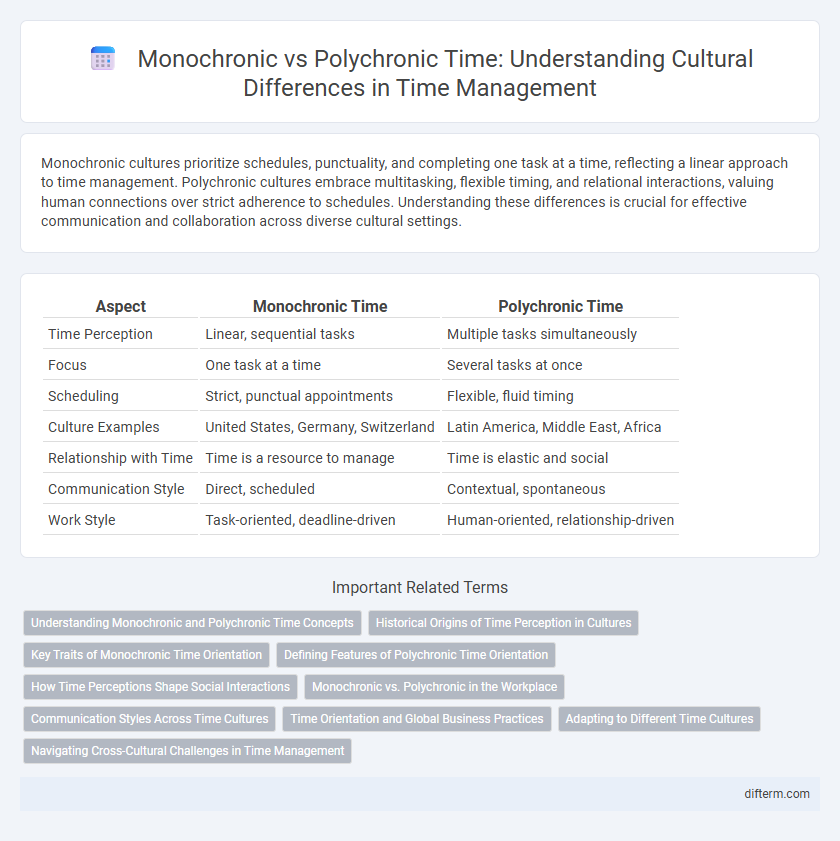Monochronic cultures prioritize schedules, punctuality, and completing one task at a time, reflecting a linear approach to time management. Polychronic cultures embrace multitasking, flexible timing, and relational interactions, valuing human connections over strict adherence to schedules. Understanding these differences is crucial for effective communication and collaboration across diverse cultural settings.
Table of Comparison
| Aspect | Monochronic Time | Polychronic Time |
|---|---|---|
| Time Perception | Linear, sequential tasks | Multiple tasks simultaneously |
| Focus | One task at a time | Several tasks at once |
| Scheduling | Strict, punctual appointments | Flexible, fluid timing |
| Culture Examples | United States, Germany, Switzerland | Latin America, Middle East, Africa |
| Relationship with Time | Time is a resource to manage | Time is elastic and social |
| Communication Style | Direct, scheduled | Contextual, spontaneous |
| Work Style | Task-oriented, deadline-driven | Human-oriented, relationship-driven |
Understanding Monochronic and Polychronic Time Concepts
Monochronic time emphasizes strict adherence to schedules, valuing punctuality and completing one task before moving to the next, commonly observed in cultures like the United States and Germany. Polychronic time prioritizes relationships and multitasking, with flexible schedules and frequent interruptions, typical in many Latin American and Middle Eastern societies. Understanding these time concepts is crucial for effective cross-cultural communication and managing expectations in diverse work environments.
Historical Origins of Time Perception in Cultures
Monochronic time perception, rooted in Western industrialization and Protestant work ethic, emphasizes linear schedules and punctuality, reflecting historical developments in European societies during the Renaissance and Enlightenment. Polychronic time, prevalent in many Indigenous, Latin American, and Mediterranean cultures, traces its origins to communal living and oral traditions, where multiple activities occur simultaneously, prioritizing relationships over strict timelines. These divergent time perceptions evolved from socio-economic structures and cultural values, shaping distinct ways communities organize daily life and interactions.
Key Traits of Monochronic Time Orientation
Monochronic time orientation emphasizes punctuality, scheduling, and completing one task at a time, reflecting a linear and structured view of time. Cultures with monochronic traits prioritize deadlines, value organization, and perceive time as a finite resource to be managed efficiently. This time perspective often leads to clear agendas and a strong focus on efficiency and planning in professional and social settings.
Defining Features of Polychronic Time Orientation
Polychronic time orientation emphasizes multitasking and fluid scheduling, valuing relationships and human interactions over strict adherence to clocks. In polychronic cultures, time is seen as flexible and cyclical, allowing for simultaneous activities and frequent interruptions without loss of productivity. This approach contrasts sharply with monochronic systems, highlighting a holistic integration of social and work-related tasks.
How Time Perceptions Shape Social Interactions
Monochronic time cultures prioritize schedules and punctuality, viewing time as a linear resource to be managed efficiently, which fosters structured social interactions centered around deadlines and clear agendas. Polychronic time cultures perceive time as flexible and fluid, emphasizing relationships and multitasking within social contexts, leading to more spontaneous and interpersonal interactions. These differing time perceptions influence communication styles, conflict resolution, and social obligations, shaping the dynamics of personal and professional relationships.
Monochronic vs. Polychronic in the Workplace
Monochronic workplaces prioritize schedules, deadlines, and punctuality, emphasizing task completion one at a time to maximize efficiency. Polychronic environments value multitasking, flexible timing, and interpersonal relationships, often accommodating interruptions and overlapping activities. Understanding these time orientation differences enhances cross-cultural communication, project management, and team dynamics in global business settings.
Communication Styles Across Time Cultures
Monochronic time cultures prioritize punctuality, linear schedules, and direct communication, emphasizing tasks and clear deadlines. Polychronic time cultures embrace multitasking, flexible schedules, and relationship-oriented communication, often valuating context and non-verbal cues over strict timeliness. Understanding these differences aids effective cross-cultural communication by aligning expectations on time management and conversational flow.
Time Orientation and Global Business Practices
Monochronic cultures prioritize punctuality, schedules, and task completion, which aligns with global business practices emphasizing deadlines and sequential project management. Polychronic cultures view time as flexible, valuing relationships and multitasking, influencing negotiation styles and collaboration in international business settings. Understanding these time orientations enhances cross-cultural communication and optimizes efficiency in global trade and multinational teamwork.
Adapting to Different Time Cultures
Adapting to monochronic time cultures requires strict adherence to schedules, punctuality, and completing tasks sequentially, emphasizing efficiency and deadlines. In polychronic time cultures, flexibility, multitasking, and prioritizing relationships over strict schedules are essential, allowing for interruptions and fluid time management. Understanding these differences enhances cross-cultural communication and improves collaboration in global business environments.
Navigating Cross-Cultural Challenges in Time Management
Monochronic cultures prioritize schedules, deadlines, and tasks sequentially, valuing punctuality and linear time management, which often contrasts with polychronic cultures that emphasize relationships and multitasking over rigid timelines. Navigating cross-cultural challenges in time management requires understanding these differing perceptions to foster effective communication and collaboration. Adapting strategies to accommodate both monochronic and polychronic preferences can enhance productivity and reduce misunderstandings in global teams.
Monochronic vs Polychronic time Infographic

 difterm.com
difterm.com